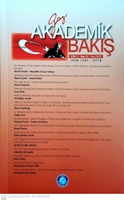NATO’s Military Structure: Change and Continuity
NATO’s Military Structure: Change and Continuity
Author(s): Ali Bilgin VarlıkSubject(s): Military history, Political history, International relations/trade, Security and defense, Military policy, Peace and Conflict Studies
Published by: Gazi Akademik Bakış
Keywords: NATO; NATO’s transformation; NATO’s military organization; transformation; change;
Summary/Abstract: The military structure of NATO is of two components; command and the force structure. Command structure comprises military headquarters responsible for the command and control of the military forces.Force structure of the Alliance is made up of forces allocated to NATO by member states. The Alliance has experienced four major transformative steps in command structure since its establishment. The initial force structure of the Alliance which covers all allocated forces including the fixed ones to NATO has gradually transformed to deployable (movable) force structure by three subsequent changes after the Cold War. The new force structure is set based upon considerations on a gradual readiness level. This paper deals with the historical changes and continuity of NATO’s both command and force structures’ transformation and their justifications -which have been rarely studied academically. Based upon this knowledge adequacy, effectiveness and rationality of both structures are scrutinised. The argument of the paper is that throughout NATO’s past the military structures has not only been a result of organizational change but also one of the main causes and determinants for the evolution and transformation of the Alliance.
Journal: Gazi Akademik Bakış
- Issue Year: 13/2020
- Issue No: 26
- Page Range: 113-134
- Page Count: 22
- Language: English

